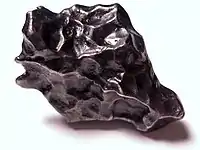regmaglypt
English
WOTD – 13 July 2018
Etymology

Regmaglypts on a fragment of the Sikhote-Alin meteorite which fell on the Sikhote-Alin Mountains in Russia in 1947
.jpg.webp)
Regmaglypts on a meteorite nicknamed “Oileán Ruaidh” on Mars, photographed on 16 September 2010 by the Mars Exploration Rover Opportunity
From Ancient Greek ῥῆγμα (rhêgma, “something broken or rent asunder; a breach, cleft, fracture”),[1] + γλυπτόν (gluptón, “carving, sculpture”).
Pronunciation
- (Received Pronunciation) IPA(key): /ˈɹɛɡməɡlɪpt/
- (General American) IPA(key): /ˈɹɛɡməɡlipt/
- Hyphenation: reg‧ma‧glypt
Noun
regmaglypt (plural regmaglypts)
- (astronomy, geology) A small, shallow indentation or pit on the surface of a meteorite, resembling a thumbprint impression in clay, created by ablation while falling in an atmosphere.
- 1960, E. L. Krinov [i.e., Yevgeny Leonidovich Krinov]; Irene Vidziunas, transl., “Morphology of Meteorites”, in Harrison Brown, editor, Principles of Meteoritics; Translated from the Russian (International Series of Monographs on Earth Sciences; 7), Oxford; London: Pergamon Press, OCLC 490032009, page 257:
- But, as the author has established, when an individual sample of a meteorite shower has a semi-orientated shape (roughly conoid, as in the given case), it must have definite morphological properties: on its front surface it must have a fully developed typical regmaglypt – relief which has had time to form during the sample's movement at cosmic speed after its separation from the main meteoric body.
- 1965 June, G. J. H. McCall, “Advances in Meteoritics in Western Australia”, in Meteoritics: The Journal of the Meteoritical Society, volume 2, number 4, Fayeteville, Ark.: Meteoritical Society, ISSN 0026-1114, OCLC 807477794, page 318:
- This, the Warburton Range meteorite, weighs 125 lbs and is a single mass […] displaying regmaglypt patterns on its surface.
- 1994, O[ran] Richard Norton, Rocks from Space: Meteorites and Meteorite Hunters, Missoula, Mont.: Mountain Press Publishing Company, →ISBN, page 141:
- The largest Henbury meteorites show beautiful regmaglypt structures. Some are oriented, displaying a shieldlike form produced when a meteoroid passes through the atmosphere without tumbling and ablates, primarily on the leading side.
- 2008, O[ran] Richard Norton; Lawrence A. Chitwood, “Meteoroids to Meteorites: Lessons in Survival”, in Field Guide to Meteors and Meteorites (Patrick Moore’s Practical Astronomy Series), London: Springer-Verlag, DOI:, →ISBN, pages 58–59:
- Another product of ablation that occurs during a meteoroid's brief atmospheric passage is the development of surface pits or regmaglypts on stones and irons alike. The common name for these is "thumb prints," since they are about the size of the human thumb. Regmaglypts in stones tend to be shallower than in irons, and are therefore not as well defined.
-
Synonyms
Derived terms
Related terms
- regma
- regmacarp
- regmatic
- rhegma
- rhegmal
- rhegmatic
- rhegmatogenic
- rhegmatogenous
Translations
small, shallow indentation or pit on the surface of a meteorite
|
|
References
- McGraw-Hill Dictionary of Scientific and Technical Terms, 6th edition, New York, N.Y.: McGraw-Hill, 2003, →ISBN.
Further reading

This article is issued from Wiktionary. The text is licensed under Creative Commons - Attribution - Sharealike. Additional terms may apply for the media files.